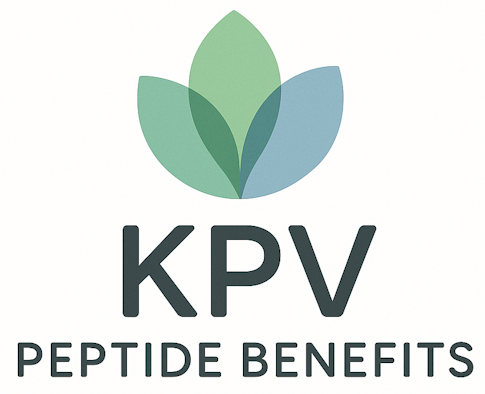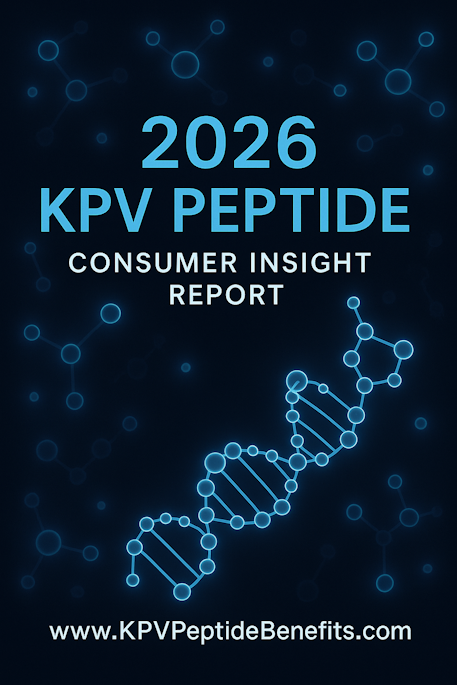Your cart is currently empty!
A comprehensive analysis of search trends, research discussions, mechanisms, safety context & consumer interest heading into 2026
Executive Summary
Public interest in KPV peptide has surged entering 2026 as consumers increasingly search for information about gut health, chronic inflammation, mucosal integrity, immune-system support, and the role of melanocortin-derived peptides in non-clinical research. Although KPV peptide is not approved for human consumption and remains designated strictly for research use, its association with anti inflammatory activity, wound healing, and epithelial protection has made it one of the most frequently searched peptides across the past year.
This report consolidates search-trend analysis, research summaries, mechanistic explanations, and consumer-behavior data to offer a clear, structured overview. It examines the origins of KPV, its relationship to alpha melanocyte stimulating hormone, and how the peptide may influence inflammatory pathways and immune responses in controlled environments. It also explains why public interest in kpv peptide benefits, kpv peptide dosage, kpv peptide side effects, oral KPV peptide, and kpv peptide injection continues to accelerate throughout 2026.
Throughout the report, frequently asked questions—such as What are the benefits of KPV peptides? Is KPV peptide safe? What is KPV peptide derived from? What is the difference between KPV and BPC-157?—are addressed within the relevant sections, offering clarity without relying on a traditional FAQ format.
The goal of this Consumer Insight Report is strictly educational: to clarify terminology, summarize non-clinical findings, and explain the trends driving renewed interest in KPV as 2026 unfolds.
1. Introduction: Why KPV Interest Is Accelerating Into 2026
Between 2024 and 2025, searches relating to KPV peptide, gut health, kpv reduces inflammation, intestinal lining, kpv safe, and similar topics rose sharply. This momentum is expected to grow as the broader cultural focus on inflammation, autoimmune conditions, and digestive-tract wellness intensifies.
Much of the public curiosity stems from KPV’s scientific background. Because the peptide is frequently discussed within the context of immune function, melanocortin receptors, inflammatory pathways, and intestinal inflammation, consumers increasingly look to it as part of a larger exploration of non-clinical wellness research. Additionally, with more social media content referencing skin conditions, contact dermatitis, chronic inflammation, and leaky gut, the peptide has entered mainstream public conversations.
As interest grows, so does confusion. Searchers are often unable to distinguish between anecdotal claims and actual research findings. This report aims to bridge that gap by providing a structured and neutral summary.
2. What KPV Peptide Is (Origins, Structure & Classification)
KPV stands for lysine–proline–valine, a tripeptide derived from the C-terminal peptide fragment of alpha melanocyte stimulating hormone (α-MSH). This parent molecule, part of the larger melanocortin family, is known for its influence on immune responses, inflammatory cells, melanocyte stimulating hormone α, and various inflammatory pathways.
Consumers frequently search for explanations about KPV’s origin, especially those wondering, “What is KPV peptide derived from?” The answer lies in its relationship to α-MSH, a hormone recognized for its anti inflammatory effects, immune-modulating activity, and potential impacts on epithelial integrity.
Because KPV peptide consists of just three amino acids, it is structurally stable and small enough to appear in research settings involving multiple routes of delivery — including oral, subcutaneous, and topical approaches. Its size also enables interactions with certain peptide transporter systems in the gastrointestinal tract, which is one reason oral administration appears frequently in online discussions.
3. Mechanisms: How KPV Interacts With Inflammatory Pathways
KPV has been examined in various controlled environments for its potential role in moderating inflammatory responses. Reports often highlight that kpv reduces inflammation or mention its potent anti inflammatory properties, but these statements refer to specific laboratory findings and do not imply suitability for therapeutic application.
Researchers have observed interactions between KPV and melanocortin receptors, which are known to play roles in regulating immune-system activity. These receptors are responsible for detecting inflammatory cues and modulating how the immune system responds. Because KPV originates from a molecule that naturally influences these receptors, its behavior in models of inflammation is of scientific interest.
In studies involving colonic epithelial cells, colonic mucosa, and epithelial surfaces, KPV appeared to influence the activity of pro inflammatory cytokines, alter certain inflammatory pathways, and support markers associated with mucosal healing and wound closure. Some research involving human bronchial epithelial cells and contact dermatitis models also noted reductions in inflammatory reactivity. These effects provide context for why KPV is increasingly searched by individuals researching skin conditions, immune balance, and gut inflammation.
4. What Research Shows (Animal Models & In Vitro Findings)
Most of the meaningful research on KPV comes from animal models, cells treated in vitro, and studies analyzing interactions with epithelial tissues across the GI tract. Some of the most frequently referenced findings involve gastrointestinal environments. These include examinations of ulcerative colitis, Crohn’s disease, intestinal inflammation, leaky gut, and gut tissues under stress. Although none of these findings translate into human therapy, they help explain why consumers researching digestive health find the peptide compelling.
Investigations into immune-modulation have similarly contributed to KPV’s visibility. Some models have shown reduced activity in inflammatory cells, improvements in immune response markers, and decreases in systemic inflammation cues. Again, these results are strictly non-clinical but align with rising consumer interest in alternatives to many anti inflammatory drugs.
Research involving epithelial surfaces, including skin-based models, has noted improvements in wound healing, faster wound closure, and responses in cells treated with irritants. These findings help contextualize why the peptide appears in public conversations about skin conditions, dermatitis, and epithelial repair.
5. KPV Peptide Benefits (Consumer Interpretations)
A large percentage of search queries focus on one primary question: “What are the benefits of KPV peptides?”
While public curiosity often associates KPV with digestive wellness or anti-inflammatory support, it is important to distinguish between research observations and consumer assumptions.
In non-clinical settings, KPV has been studied for its potential to reduce inflammatory responses, support gut tissues, influence behavior in colonic epithelial cells, and modulate certain immune-related markers. Researchers have noted patterns suggesting impacts on immune function, tissue repair, and epithelial balance.
These findings contribute to the perception that kpv reduces inflammation or supports gut health, and explain why terms like anti inflammatory benefits, anti inflammatory effect, and potent anti inflammatory activity appear frequently in online discussions. However, these interpretations do not support therapeutic claims.
6. KPV Peptide Dosage & Delivery Routes (Oral, Injection, Topical)
Search interest in kpv peptide dosage and delivery formats has increased sharply. Much of the curiosity relates to two dominant themes: the structural simplicity of KPV and the possibility of multiple routes of administration.
Public conversations about oral KPV peptide often reference the peptide’s compatibility with certain peptide transporter pathways in the digestive tract and GI tract. Some studies suggest that its small molecular structure may enable absorption in specific contexts, which explains why orally delivered formulations have become a major topic in online forums.
At the same time, interest in subcutaneous injection stems from laboratory use cases where KPV was evaluated locally in tissues undergoing irritation or inflammation. Discussions of topical or localized formats also appear, particularly in research examining skin surfaces and contact dermatitis.
It is important to emphasize that none of these delivery routes apply to approved therapies. Variability in purity, drug delivery, formulation stability, and interaction with epithelial surfaces means that no standardized KPV dosage exists for human use.
7. Side Effects, Safety Notes & Misinterpretations
Consumers frequently search: “Is KPV peptide safe to take?”
The report clarifies that while some models describe kpv safe profiles with limited adverse effects, these findings emerge exclusively from controlled settings such as animal models, in vitro systems, and studies involving untreated cells as comparison groups.
Because KPV has not gone through large-scale clinical trials, safety conclusions cannot be drawn for human application. Much of the confusion stems from online discussions that blend research observations with personal anecdotes. The report outlines the boundaries clearly: while certain models show encouraging results, these do not constitute evidence for human consumption or medical treatment.
8. KPV vs. BPC-157 (Consumer Comparison)
Another widely searched topic is the difference between KPV peptide and BPC-157. The report explains that although both appear in inflammation- and healing-related discussions, they operate through distinct biological systems.
KPV originates from alpha melanocyte stimulating hormone and tends to appear in research involving gut inflammation, colonic mucosa, immune responses, and epithelial cell behavior. BPC-157, by contrast, is derived from a gastric protein fragment and is more frequently associated with tissue regeneration, tendon models, orthopedic discussions, and angiogenesis pathways.
This distinction helps answer the consumer question: “What is the difference between KPV and BPC-157?”
9. Consumer Behavior & Search Trends Going Into 2026
Entering 2026, interest in kpv peptide continues to climb across multiple demographic segments. More individuals are researching inflammation, digestive wellness, skin integrity, and epithelial recovery. This aligns with broader public attention toward chronic conditions, leaky gut, ulcerative colitis, and immune balance.
Searches that combine peptide terminology with digestive or immune-system concepts—such as kpv reduces, reducing inflammation, intestinal lining, or immune cells—have increased steadily. Keywords related to kpv peptide benefits, kpv safe, and oral administration also remain strong.
These patterns indicate that consumers are increasingly sophisticated in their peptide-related research, often distinguishing between gut-focused peptides and compounds associated with tendon or musculoskeletal recovery.
10. Buying Patterns & Market Shifts
Even though KPV is designated for research use, search-pattern analysis suggests a growing interest in sourcing information about formulation quality, comparisons between oral and injectable formats, and distinctions between peptides derived from the parent molecule (α-MSH) versus synthetically produced fragments.
Consumers also appear increasingly interested in understanding what kpv stands for (lysine–proline–valine), how it differs from other anti-inflammatory peptide fragments, and what factors influence purity, stability, or drug delivery pathways.
These shifts in behavior show that individuals researching KPV are generally well-informed and focused on scientific context rather than casual experimentation.
11. Outlook for 2026: What Observers Are Watching
As 2026 continues, researchers and consumers alike are watching several areas closely. These include:
- New evaluations of epithelial cells, colonic cells, and immune signaling
- Better characterization of anti inflammatory effect mechanisms
- Expanded discussions of chronic conditions and GI-related inflammation
- The growing relationship between immune modulation and digestive wellness
Given that KPV is linked to multiple areas of early-stage investigation—including mucosal healing, wound closure, and inflammatory pathways—its relevance is likely to increase throughout 2026.
12. Access the Full Educational Resource
Readers seeking additional research summaries, educational guides, glossary terms, and expanded discussions can visit:
👉 https://www.kpvpeptidebenefits.com/
The resource will continue to be updated as new 2026 insights, trends, and public-interest patterns emerge.

